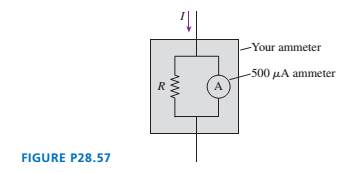
A circuit you’re building needs an ammeter that goes from 0 mA to a full-scale reading of 50 mA. Unfortunately, the only ammeter in the storeroom goes from
a. What value of R must you use so that the meter will go to full scale when the current I is 50 mA?
b. What is the effective resistance of your ammeter?

Want to see the full answer?
Check out a sample textbook solution
Chapter 28 Solutions
PHYS 212 FOR SCI+ENG W/MAST PHYS >ICP<
- = 12 kg, and m3 Three objects with masses m₁ = 3.8 kg, m₂ find the speed of m3 after it moves down 4.0 m. m/s 19 kg, respectively, are attached by strings over frictionless pulleys as indicated in the figure below. The horizontal surface exerts a force of friction of 30 N on m2. If the system is released from rest, use energy concepts to m m2 m3 iarrow_forwardThree objects with masses m₁ = 3.8 kg, m₂ = 12 kg, and m 19 kg, respectively, are attached by strings over frictionless pulleys as indicated in the figure below. The horizontal surface exerts a force of friction of 30 N on m2. If the system is released from rest, use energy concepts to find the speed of m¸ after it moves down 4.0 m. m/s m m2 mgarrow_forwardIn order for Jane to return to base camp, she needs to swing across a river of width D that is filled with alligators. She must swing into a wind exerting constant horizontal force F, F = 110 N, L = 40.0 m, 0 = 50.0°, and her mass to be 50.0 kg. Wind →F Tarzan! Jane (a) with what minimum speed (in m/s) must Jane begin her swing to just make it to the other side? (If Jane can make it across with zero initial velocity, enter 0.) m/s on a vine having length L and initially making an angle with the vertical (see below figure). Take D = 48.0 m, (b) Shortly after Jane's arrival, Tarzan and Jane decide to swing back across the river (simultaneously). With what minimum speed (in m/s) must they begin their swing? Assume that Tarzan has a mass of 80.0 kg. m/sarrow_forward
- R=2.00 12V 2.00 4.00 4.002 What is the current in one of the 4.0 Q resistors? An isolated point charge q is located at point X. Two other points Y and Z are such that YZ2 XY. Y X What is (electric field at Y)/(electric field at Z)?arrow_forwardTwo objects (m₁ = 4.75 kg and m₂ 2.80 kg) are connected by a light string passing over a light, frictionless pulley as in the figure below. The 4.75-kg object is released from rest at a point h = 4.00 m above the table mg m (a) Determine the speed of each object when the two pass each other. m/s (b) Determine the speed of each object at the moment the 4.75-kg object hits the table. m/s (c) How much higher does the 2.80-kg object travel after the 4.75-kg object hits the table? marrow_forwardA cell of negligible internal resistance is connected to three identical resistors. The current in the cell is 3.0 A. The resistors are now arranged in series. What is the new current in the cell?arrow_forward
- A negatively charged sphere is falling through a magnetic field. north pole of magnet direction of motion south pole of magnet What is the direction of the magnetic force acting on the sphere?arrow_forwardElectrons in a conductor are moving down the page. A proton outside the wire is moving to the right. What is the direction of the magnetic force acting on the proton?arrow_forwardWhat is the resistance of an ideal voltmeter and the resistance of an ideal ammeter? Resistance of an ideal voltmeter Resistance of an ideal ammeter infinite A. zero B. zero zero C. infinite infinite D. infinite zeroarrow_forward
- variable resistor with a resistance range of 0 to 6.0 KQ is connected in series with two resistors of fixed value 6.0 KQ. The cell in the circuit has an emf of 18 V and a negligible internal resistance. 18 V X Y 6.0 ΚΩ 6.0 ΚΩ 0 - 6.0 ΚΩ What is the maximum range of potential difference that can be observed between X and Y?arrow_forwardA positive point charge of magnitude 1.0 μC and a point charge q are separated by a distance d. electron 1.0 με An electron is placed at a distance d from the +1.0 μC charge. The electric force on the electron is zero. What is q?arrow_forwardTwo point charges of +4q and -q are placed a fixed distance apart. Where is the electric field strength equal to zero? B. +49 D. A network of three resistors is connected to a cell of emf 12V and internal resistance R of 2.0 Q as shown.arrow_forward
 Physics for Scientists and Engineers: Foundations...PhysicsISBN:9781133939146Author:Katz, Debora M.Publisher:Cengage Learning
Physics for Scientists and Engineers: Foundations...PhysicsISBN:9781133939146Author:Katz, Debora M.Publisher:Cengage Learning Physics for Scientists and Engineers, Technology ...PhysicsISBN:9781305116399Author:Raymond A. Serway, John W. JewettPublisher:Cengage Learning
Physics for Scientists and Engineers, Technology ...PhysicsISBN:9781305116399Author:Raymond A. Serway, John W. JewettPublisher:Cengage Learning Physics for Scientists and EngineersPhysicsISBN:9781337553278Author:Raymond A. Serway, John W. JewettPublisher:Cengage Learning
Physics for Scientists and EngineersPhysicsISBN:9781337553278Author:Raymond A. Serway, John W. JewettPublisher:Cengage Learning Physics for Scientists and Engineers with Modern ...PhysicsISBN:9781337553292Author:Raymond A. Serway, John W. JewettPublisher:Cengage Learning
Physics for Scientists and Engineers with Modern ...PhysicsISBN:9781337553292Author:Raymond A. Serway, John W. JewettPublisher:Cengage Learning
 Principles of Physics: A Calculus-Based TextPhysicsISBN:9781133104261Author:Raymond A. Serway, John W. JewettPublisher:Cengage Learning
Principles of Physics: A Calculus-Based TextPhysicsISBN:9781133104261Author:Raymond A. Serway, John W. JewettPublisher:Cengage Learning





